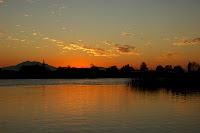 |
| photo credit Dan Blanton |
By Dr. Mark Rockwell
V.P. Conservation
NCCFFF
Pacific Coast Representative
Endangered Species Coalition
V.P. Conservation
NCCFFF
Pacific Coast Representative
Endangered Species Coalition
The S.F. Bay-Delta is the largest fresh & salt water estuary in the west coast of the Americas. It covers an area of approximately 1,100 square miles, and extends from Stockton in the South, Sacramento to the north, and to the S.F. Bay to the West. If we want to include the entire watershed, we would have to include all of the western flank of the Sierra Nevada, the southern reaches of the southern Cascades and the eastern flanks of the Coastal range that borders both the San Joaquin and Sacramento valleys. This is an area bigger than many states. As a watershed it is immense, and as such, is home to many threatened and endangered species.
Development of this estuary/watershed began in the 1800’s and continues today. Water is its most important resource for California. Most of southern California is arid, and cannot provide enough water to serve the 10s of millions of residents there. Starting in the early 1900’s California began to use water from the Bay-Delta for agriculture, and by the middle of the century began to dam and divert the watershed to access more of its aquatic resources. Today, approximately 24 million Californians are dependant upon the Bay-Delta for water, and the federal Central Valley Project (CVP), and the state water project (SWP) are the largest water conveyance projects in the country. These two systems move water from as far north as the Trinity River in northwestern California to as far south as San Diego, and many points in between.
 |
| photo credit Jerry Neuburger |
Over the years increasing amounts of water have been diverted from the system, with diversions during the past 10 years being more than 50% of total inflows. During this same period the ecosystem of the Delta was characterized as crashing, with historic low numbers of both pelagic (in-Delta) and anadromous (trans-Delta) fish species. Some of the species affected are: Chinook salmon, Steelhead, Green Sturgeon, Striped Bass, Delta Smelt and Splittail Smelt among others. This crash includes the plankton and other food sources they need for survival. Several of these are listed as either threatened or endangered under the federal Endangered Species Act (ESA).
In 2009, because of continued conflict over what to do, the state legislature made the decision to create a new state entity to solve the problems (SBX7-1, Chapter 5), and created the Delta Stewardship Council. They are tasked with creating a Delta Plan that protects, restores and enhances the Bay-Delta ecosystem, and provides a more reliable water supply for California (co-equal goals). This has to be completed by January, 2012. The council is currently taking recommendations for alternative strategies to be evaluated under the Environmental Impact Statement for the Delta Plan.
Many groups and people in California recognize this as an opportunity to finally change the way California manages water. On January 25, 2011 a group of 30 environmental, environmental justice and fishing groups (including the Federation of Fly Fishers and Endangered Species Coalition) submitted detailed recommendations to the Council on two primary areas of the Plan – Water Resources and Restoration. These recommendations are to provide effective and manageable methods to achieve enough water for California, both today and in the future, as well as recover and restore the Delta watershed. They feel it is essential to find ways to answer the needs for water without more damage to the watershed, its fisheries and the many disadvantaged communities affected by poor water quality. They also feel there is no way to recover the many species now listed under the Endangered Species Act (ESA) unless the state moves in a new direction with water management.
California currently stands as a focus for ESA conflicts because further degradation of the watershed in the Delta will cause more restrictive actions to protect fish and wildlife. Only by reducing the demand for water from the Delta, and providing needed restoration can we stop the decline of fish and wildlife. It is essential that the state find the balance required under the legislation, but it can no longer rely on managing water like it has for the past 75 or more years. We are in a new era, with new challenges, and new constraints. This requires new thinking, taking a different path to water reliability, and the political will to push for methods that reduce Delta demands. We encourage the Delta Stewardship Council to resist the old pressures for the status quo, and push for new and innovative strategies on water management. They will need to work through the impacts on business and communities so the changes happen over time, and allow for everyone to adapt successfully. This is an 88 year plan, so the changes can be phased over years, and the impacts mitigated responsibly.
To view the recommendations made to the Delta Stewardship Council by the 30 state groups: https://www.ewccalifornia.org
To contact the Delta Stewardship Council go to: www.deltacouncil.ca.gov. If in California, you can submit comments online through the ESC action page or email the council directly at terry.macaulay@deltacouncil.ca.gov
To view the Endangered Species Coalition top 10 report, It’s Getting Hot Out There: Top 10 Places to Save for Endangered Species in a Warming World, go to: https://www.itsgettinghotoutthere.org/
***
This is a guest post by NCCFFF, as part of our occasional series from Endangered Species Coalition member organizations


0 comments on “The San Francisco Bay-Delta Watershed – Change is on the Horizon for California”